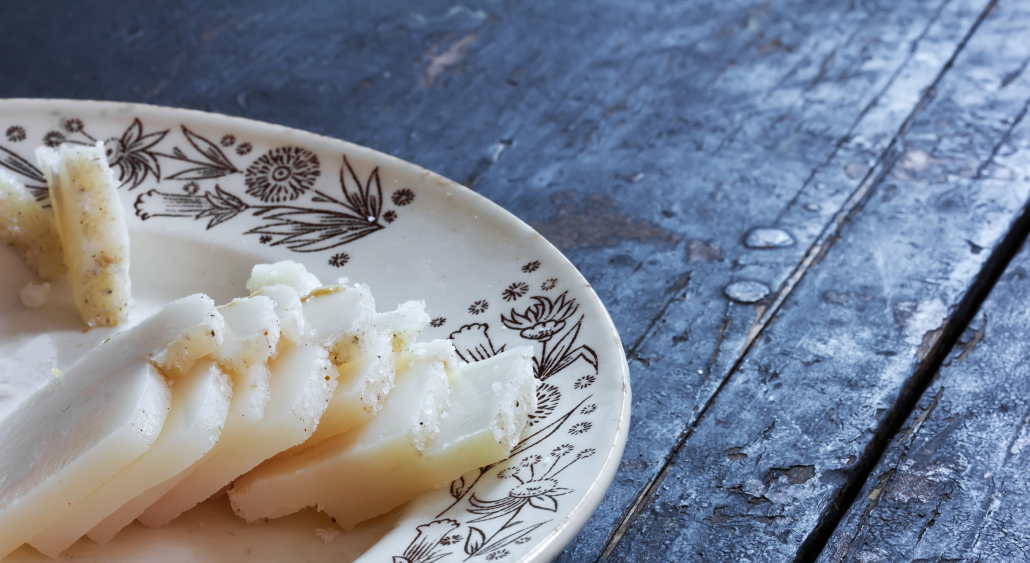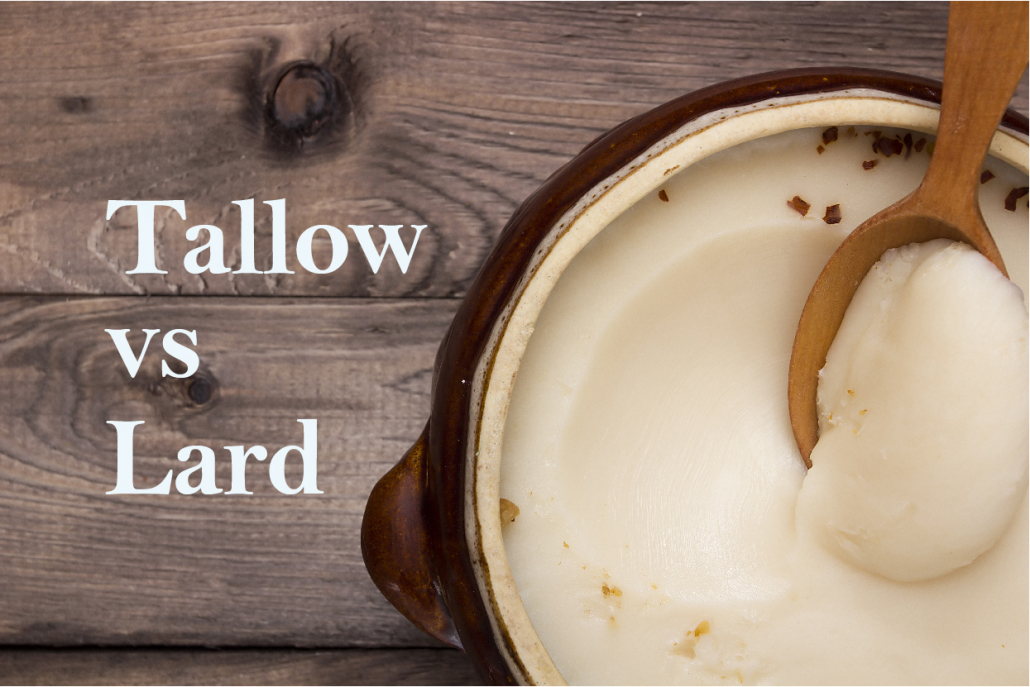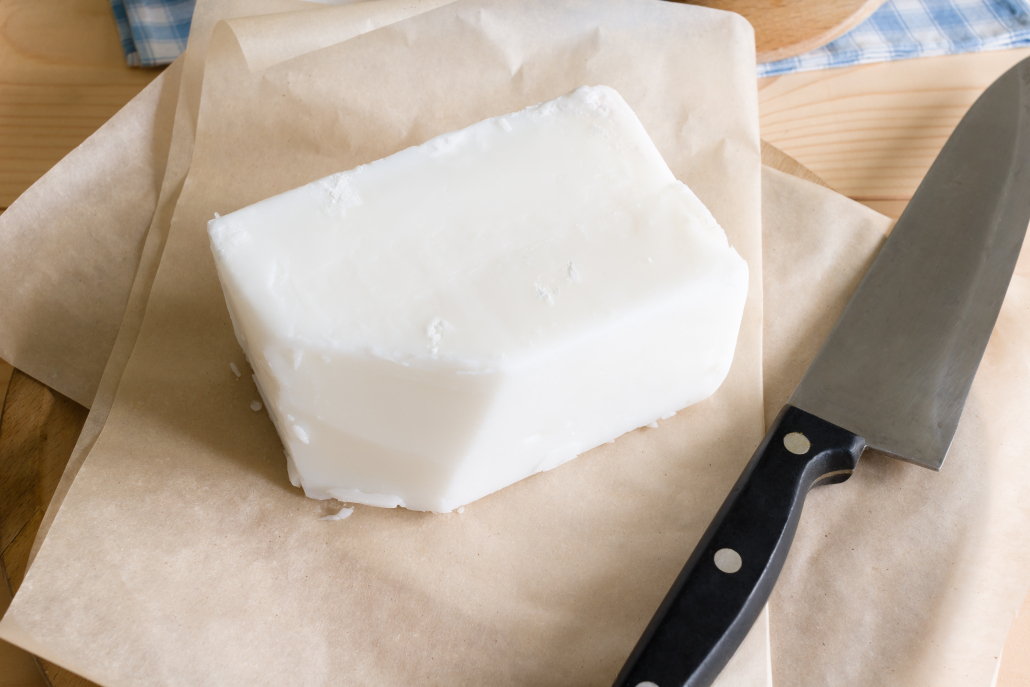We include products in articles we think are useful for our readers. If you buy products or services through links on our website, we may earn a small commission.
What is Tallow? Types, Nutrition, and Benefits

Table of Contents
Tallow is a true carnivore diet staple. It’s nutritious, highly satiating, and versatile.
Although most people automatically think beef when they picture tallow, this cooking fat can come from other animals, too. The fat of mutton, lambs, and pigs can all be made into tallow.
Saturation Matters
In an ideal world, all animals would eat their native diet, giving them naturally healthy fat stores.
But for most animals raised on modern feedlots, their diets are anything but natural. As a consequence, their muscles become tougher and their fat becomes less saturated. In short, they’re not as healthy.
Pigs and other non-ruminant animals have it the worst. According to pig farmer Brad Marshall, the quality of these animal foods just isn’t what it used to be:
“Unlike ruminant animals, who actually hydrogenate their dietary fats, pigs and chickens are what they eat, at least from the perspective of fat composition. Animals are not capable of producing polyunsaturated fats (PUFAs), therefore their fat will only contain PUFA if we feed them PUFA, period. The PUFA levels of pork and chicken are completely in our control.”
If you’re going to eat tallow from pigs or other non-ruminant animals, make sure they’re coming from a good pastured source.
Tallow from properly fed animals is around 50% saturated, 45 percent monounsaturated, and only 5 percent polyunsaturated. The fat rendered from pasture-raised pigs can offer as much vitamin D as cod liver oil.
You can gauge tallow’s saturation levels by its physical qualities; any tallow product you buy or make should be solid at room temperature. The more saturated the tallow, the higher its melting point will be.
Tallow Nutrition Facts
Tallow is both nutrient and energy-dense. A single tablespoon of tallow contains 110+ calories and 12+ grams of fat. Tallow is free of carbohydrates, making it great for your keto, low-carb, or carnivore diet.
Tallow is also generally high in fat-soluble vitamins, including vitamins A, D, E, K2, and others.
Beef tallow
Beef tallow is rendered fat from a cow. To render fat, you melt it and heat at a low temperature. Eventually, all the proteins solidify and the water evaporates. The solids are filtered from the fat, and once cooled, you’re left with pure fat.
Beef tallow is the most common type of tallow. Even low-quality beef tallow may be more nutritious than other animal types, since cows can convert the unhealthy fats they eat into healthier forms of energy.
The very healthiest beef tallow comes from grass-fed cattle. Grass-fed tallow is higher in healthy saturated fats, omega 3’s, stearic acid, and conjugated linoleic acid (CLA) than ‘regular’ tallow. It also provides other fat-soluble nutrients like:
- Vitamin A
- Vitamin D
- Vitamin E
- Vitamin K2
- Vitamin B12
- Choline
| Macronutrient | Per tablespoon | Per 100 grams |
| Calories | 115 calories | 902 calories |
| Carbohydrates | 0 grams | 0 grams |
| Total Fat | 12.8 grams | 100 grams |
| Saturated | 6.4 grams (50%) | 50 grams |
| Monounsaturated | 5.4 grams (42%) | 42 grams |
| Polyunsaturated | 0.5 grams (3.9%) | 3.9 grams |
| Omega 3 | 0.1 grams (0.7%) | 0.7 grams |
| Omega 6 | 0.2 grams (1.5%) | 1.5 grams |
| Protein | 0 grams | 0 grams |
Mutton Tallow
Mutton tallow is rendered fat from a fully-grown sheep. Mutton tallow is most common in countries that consume large amounts of sheep and lamb. In some countries, ‘fat-tail sheep’ that store extra fat under their tails are specifically used for tallow production.
Though mutton tallow tastes different from beef tallow, its fatty acid profile is quite similar. It is rich in palmitic acid, stearic acid, and oleic acid. It also contains large amounts of naturally occurring healthy trans fats like CLA.
| Macronutrient | Per tablespoon | Per 100 grams |
| Calories | 115 calories | 902 calories |
| Carbohydrates | 0 grams | 0 grams |
| Total Fat | 13.3 grams | 100 grams |
| Saturated | 6.1 grams (47%) | 47.3 grams |
| Monounsaturated | 5.2 grams (41%) | 40.6 grams |
| Polyunsaturated | 1 gram (7.8%) | 7.8 grams |
| Omega 3 | 0.3 grams (2.3%) | 2.3 grams |
| Omega 6 | 0.7 grams (5.5%) | 5.5 grams |
| Protein | 0 grams | 0 grams |
Lamb Tallow
Lamb tallow is rendered fat from a young sheep or lamb. Lamb tallow is also common in countries that consume large amounts of sheep and lamb. The nutritional profiles of lamb tallow and mutton tallow are very similar, with some sources saying that lamb tallow has slightly more calories.
| Macronutrient | Per tablespoon | Per 100 grams |
| Calories | 120 calories | 941 calories |
| Carbohydrates | 0 grams | 0 grams |
| Total Fat | 13.3 grams | 100 grams |
| Saturated | 6.1 grams (47%) | 47.3 grams |
| Monounsaturated | 5.2 grams (41%) | 40.6 grams |
| Polyunsaturated | 1 gram (7.8%) | 7.8 grams |
| Omega 3 | 0.3 grams (2.3%) | 2.3 grams |
| Omega 6 | 0.7 grams (5.5%) | 5.5 grams |
| Protein | 0 grams | 0 grams |
Pig & Hog Tallow
Pig or hog tallow is rendered fat from a pig. This type of tallow, also called lard, has been a favorite of professional chefs and cooking enthusiasts for centuries.
As we said earlier in this article, the quality of pig/hog tallow matters. Pigs that are fed a traditional diet of barley and milk have lower levels of unhealthy PUFAs — and higher levels of heart-healthy saturated fats, like stearic acid and palmitic acid.
| Macronutrient | Per tablespoon | Per 100 grams |
| Calories | 116 calories | 902 calories |
| Carbohydrates | 0 grams | 0 grams |
| Total Fat | 12.8 grams | 100 grams |
| Saturated | 5 grams (39%) | 39 grams |
| Monounsaturated | 5.8 grams (45%) | 45.1 grams |
| Polyunsaturated | 1.4 grams (11.2%) | 11.2 grams |
| Omega 3 | 0.1 grams (1%) | 1 gram |
| Omega 6 | 1.3 grams (10.2%) | 10.2 grams |
| Protein | 0 grams | 0 grams |
Health Benefits of Tallow
The health benefits of tallow are numerous. They can be divided 5 key categories:
- Heart benefits
- Metabolic benefits
- Absorption-enhancing benefits
- Skincare benefits
- Practical benefits
Improves Heart Health
Tallow is an incredible source of dietary cholesterol. Yet consuming tallow has been shown to have only a minor effect on serum cholesterol levels for most people.
Research has found that tallow’s stearic acid component has a unique cholesterol-balancing effect. Stearic acid, unlike the omega-6’s found in most vegetable fas, activates the mitochondria (energy centers) in cells. In effect, it switches on your metabolism, speeding the conversion of dietary cholesterol into important hormones.
Consumption of stearic acid found in abundance in tallow may reduce your risk of cardiovascular disease, type 2 diabetes, insulin resistance, and more. All of this is positive news for heart health.
Additionally, studies show that in countries where cows eat more grass, and therefore have higher levels of beneficial fat called conjugated linoleic acid (CLA), the people with the highest amount of CLA in their bodies have the lowest risk of heart disease. This is another reason to choose grass-fed tallow where available.
Activates Metabolism
Tallow is rich in naturally occurring trans fats, like CLA and other oleic acid isomers. These fatty acids may boost your metabolism while offering anti-inflammatory and anti-cancer properties.
The stearic acid we keep mentioning is also to credit here: animals overfed stearic acid don’t gain any appreciable weight. Human studies have confirmed that stearic acid ‘flips the switch’ and turns on mitochondrial fat burning. This in turn reduces risk of cancer and heart disease.
While more research is needed on this topic, adding tallow to your keto diet may accelerate keto’s fat-burning qualities while limiting inflammation.
Enhances Vitamin Absorption
Fat-soluble vitamins need to be taken alongside fat in order to be fully absorbed.
As a rich source of both fat and fat-soluble vitamins, tallow essentially knocks out two birds with one stone. It can also be used to improve the bioavailability of nutrients in other foods.
One study found that the beta-carotene (vitamin A) in salad is better absorbed when it’s served with high-fat canola oil dressing.
Canola oil is far from the healthiest choice, however. Other studies have found that olive oil boosts the bioavailability of carotenoids far better than less saturated options like corn or canola. And tallow is even more saturated than olive oil. 45-40% respectively.
Yet another study showed that sunflower oil reduces beta-carotene’s bioavailability to 11%, while beef tallow increases its bioavailability by 17%.
Furthermore, the easily oxidized fats in sunflower oil may allow all sorts of vitamins and minerals to get degraded prior to complete absorption. And it can also cause the oxidation of LDL cholesterol that leads to heart disease.
So protect yourself by choosing saturated (molecularly stable) animal fats over highly processed unsaturated vegetable oils.
Heals and Nurtures Your Skin
When considering that tallow activates your mitochondria–the energy factories in your cells–it’s no surprise that it speeds up cellular regeneration on a topical level.
Studies show that tallow promotes skin cell regeneration, allowing your skin to renew and regenerate itself at a faster rate.
Tallow’s fatty acids can also act as a natural sealant that locks moisture into your skin, keeping it healthy and hydrated. In fact, tallow’s fatty acid profile closely matches the profile of your skin’s sebum oil, allowing it to naturally integrate on a molecular level.
Other potential skincare benefits include:
- Reduced dryness
- Improved moisture
- Faster wound healing
- Increased skin flexibility
- Improved skin barrier function
To experience tallow’s best skin care-centric effects, simply apply well-filtered tallow topically.
Practical Benefits
Tallow has a higher smoke point than most other cooking fats/oils (with the sole exception of ghee). It can reach temperatures of up to 480℉ before it starts to burn.
In addition to smoking less than other cooking oils, tallow produces fewer free radicals than canola oil or olive oil when it’s heated.
How to make Tallow
Making tallow is easy. All you need is animal fat, a knife, and a large pan or slow cooker.
The first step is sourcing. Opt for grass-fed, organic fat if you can — this will probably be available at a local farmers’ market or health food store. Ask your butcher if they keep grass-fed fat trimmings, too.
- Obtain some animal fat, preferably grass-fed.
- Ask your butcher to cut it up into chunks for you (optional), or
- Cut your animal fat into cubes yourself, using a large knife.
- Place the cubed fat into a slow cooker or pan on low heat.
- Listen carefully for crackling noises — that’s a sign your tallow is in the making!
- Once the crackling stops, take a peek at your tallow. There should be just liquid and crispy pieces (they’re called cracklings) leftover.
- Let your tallow cool for about 10 minutes, then strain it through a fine mesh and store in a glass or steel container.
- Enjoy adding tallow to keto and carnivore dishes!
What is tallow used for? Just about anything you’d like. Frying eggs, organ meats, seafood, or low-carb veggies in tallow leads to a predictably tasty meal — and a smoke-free kitchen. It’s also an excellent way to ensure you’re meeting your macronutrient ratio needs.
Most meat, even fatty cuts, need more fat to reach the 80%-20%, fat-to-protein ratio that’s ideal for most low-carb diets.
Tallow: The Overview
Tallow is a delicious, healthy, and versatile fat that offers good nutrition at a very affordable price. It has a wide variety of health benefits, including:
- Improved heart-health
- Boosts metabolism
- Enhances vitamin and mineral absorption
- Protects and regenerates skin
In an age of overpriced, overhyped ‘superfoods,’ tallow is a humble fat source that provides truly super nutrition.














